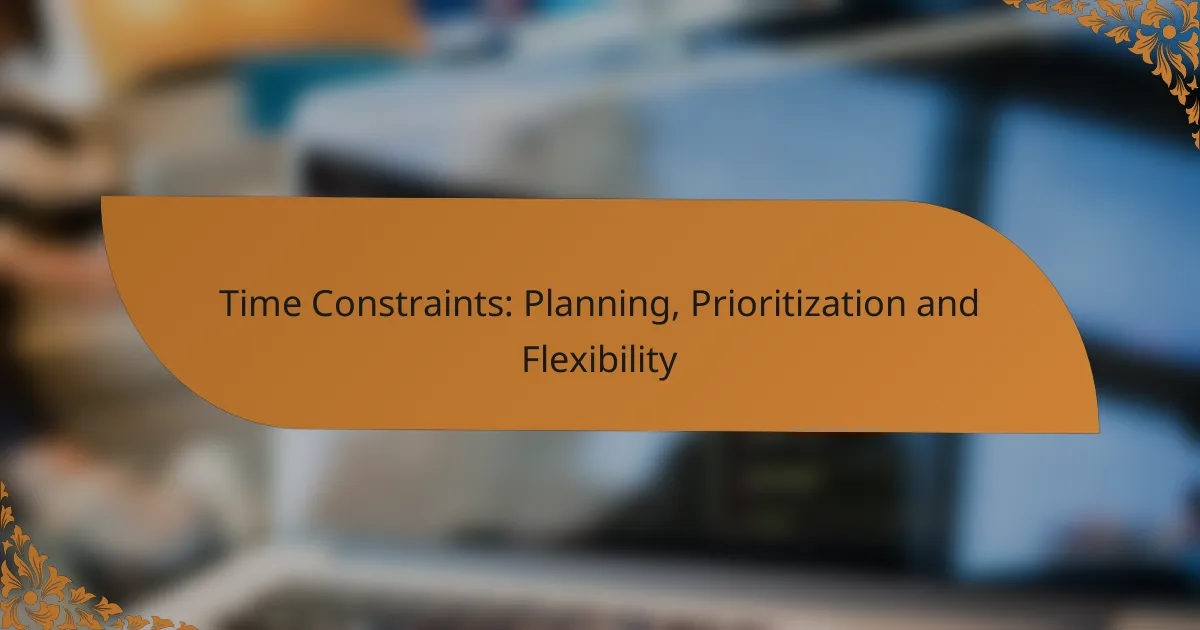Time constraints can pose significant challenges in both personal and professional settings, making effective planning essential. By prioritizing tasks and setting clear goals, individuals can enhance their productivity, even under pressure. Additionally, maintaining flexibility allows for adjustments as circumstances change, ensuring that objectives are still met efficiently.

How to effectively plan under time constraints?
Effective planning under time constraints involves prioritizing tasks, setting clear goals, and maintaining flexibility. By employing structured techniques, you can maximize productivity even when time is limited.
Time-blocking techniques
Time-blocking is a method where you allocate specific blocks of time to different tasks or activities throughout your day. This approach helps to minimize distractions and enhances focus by creating a structured schedule.
To implement time-blocking, start by identifying your most important tasks and estimating how long each will take. For instance, you might block out two hours in the morning for project work and one hour in the afternoon for meetings. Adjust these blocks as necessary to accommodate urgent tasks.
Setting SMART goals
SMART goals are Specific, Measurable, Achievable, Relevant, and Time-bound objectives that provide clarity and direction. Setting these types of goals helps you focus on what truly matters within your time constraints.
For example, instead of saying “I want to improve my sales,” a SMART goal would be “I aim to increase my sales by 15% within the next quarter.” This specificity allows for better tracking and accountability.
Utilizing project management tools
Project management tools like Trello, Asana, or Microsoft Teams can streamline your planning process. These tools allow you to visualize tasks, set deadlines, and track progress, making it easier to manage time-sensitive projects.
When choosing a tool, consider your team’s needs and the complexity of your projects. Many tools offer free versions, which can be a good starting point for small teams or individual use.
Establishing deadlines
Establishing clear deadlines is crucial for effective planning under time constraints. Deadlines create a sense of urgency and help prioritize tasks based on their importance and time sensitivity.
When setting deadlines, be realistic about the time required for each task. Use techniques like backward planning, starting from the final deadline and working backward to allocate time for each step. This method ensures that all components are accounted for and helps avoid last-minute rushes.
Delegating tasks
Delegating tasks effectively can alleviate pressure and enhance productivity when time is limited. By assigning responsibilities to team members, you can focus on higher-priority tasks and ensure that work progresses smoothly.
Identify team members’ strengths and assign tasks accordingly. For example, if someone excels in data analysis, delegate related tasks to them. This not only speeds up the process but also empowers team members and fosters collaboration.

What prioritization methods can enhance productivity?
Effective prioritization methods can significantly boost productivity by helping individuals and teams focus on the most important tasks. By using structured approaches, you can clarify what needs immediate attention and what can wait, ensuring efficient use of time and resources.
Eisenhower Matrix
The Eisenhower Matrix categorizes tasks into four quadrants based on urgency and importance. This method helps you identify what to focus on immediately, what to schedule for later, what to delegate, and what to eliminate altogether.
To use this matrix, draw a square divided into four sections: Quadrant 1 for urgent and important tasks, Quadrant 2 for important but not urgent tasks, Quadrant 3 for urgent but not important tasks, and Quadrant 4 for neither urgent nor important tasks. For example, responding to a critical client issue might fall into Quadrant 1, while planning a long-term project could be in Quadrant 2.
MoSCoW method
The MoSCoW method prioritizes tasks into four categories: Must have, Should have, Could have, and Won’t have this time. This framework helps teams focus on delivering the most critical features or tasks first, ensuring that essential needs are met before addressing less critical ones.
When applying the MoSCoW method, start by identifying the “Must have” tasks that are non-negotiable for project success. For instance, a software release may require core functionalities as “Must haves,” while additional features can be classified as “Should” or “Could” haves, depending on their impact on the overall project.
ABC prioritization
ABC prioritization is a straightforward method that ranks tasks into three categories: A (high priority), B (medium priority), and C (low priority). This approach allows for quick decision-making regarding which tasks to tackle first based on their significance and deadlines.
To implement ABC prioritization, list all tasks and assign each one a letter based on its urgency and importance. For example, completing a project proposal due tomorrow might be an “A” task, while organizing files could be a “C” task. Focus on “A” tasks first to maximize productivity and meet critical deadlines.

How to maintain flexibility in planning?
Maintaining flexibility in planning involves adapting to changes while ensuring that goals are met. This can be achieved through effective methodologies, regular assessments, and strategic scheduling.
Adopting agile methodologies
Agile methodologies emphasize iterative progress and adaptability, allowing teams to respond quickly to changes. By breaking projects into smaller tasks, teams can reassess priorities and adjust plans based on current needs.
Common agile practices include daily stand-ups and sprint reviews, which foster communication and collaboration. Implementing these methods can significantly enhance a team’s ability to pivot when necessary.
Regularly reviewing progress
Consistent progress reviews are essential for maintaining flexibility in planning. By evaluating project milestones and outcomes at regular intervals, teams can identify any deviations from the plan and make timely adjustments.
Consider setting up weekly or bi-weekly check-ins to discuss progress and challenges. This practice not only keeps everyone aligned but also encourages proactive problem-solving.
Building buffer time into schedules
Incorporating buffer time into project schedules allows for unexpected delays and changes without derailing overall timelines. A good rule of thumb is to allocate an additional 10-20% of the total project time as buffer space.
For example, if a project is estimated to take 4 weeks, planning for 4.5 to 5 weeks can provide the necessary flexibility. This approach helps manage stress and improves the quality of work by allowing teams to focus on delivering results rather than rushing to meet deadlines.

What are common challenges in time management?
Common challenges in time management include procrastination, overcommitting, and a lack of clarity in goals. These issues can hinder productivity and lead to increased stress, making it essential to address them effectively.
Procrastination
Procrastination is the act of delaying tasks, often due to fear of failure or feeling overwhelmed. It can lead to last-minute rushes and lower quality work, which can affect overall performance.
To combat procrastination, break tasks into smaller, manageable steps and set specific deadlines for each. Using techniques like the Pomodoro Technique, where you work for 25 minutes and then take a 5-minute break, can also help maintain focus.
Overcommitting
Overcommitting occurs when individuals take on more tasks than they can realistically handle, leading to burnout and missed deadlines. This often stems from a desire to please others or a lack of awareness of personal limits.
To avoid overcommitting, assess your current workload before agreeing to new tasks. A good rule of thumb is to leave at least 20% of your schedule open for unexpected tasks or breaks, ensuring you maintain a balanced workload.
Lack of clarity in goals
A lack of clarity in goals can lead to confusion and wasted time, as individuals may not know what tasks to prioritize. Clear, specific goals provide direction and help focus efforts on what truly matters.
To improve goal clarity, use the SMART criteria—ensuring goals are Specific, Measurable, Achievable, Relevant, and Time-bound. Regularly review and adjust your goals to keep them aligned with your priorities and changing circumstances.

How can technology assist in time management?
Technology can significantly enhance time management by providing tools that help individuals and teams track their time, prioritize tasks, and collaborate efficiently. Utilizing these tools can lead to better organization and increased productivity.
Time-tracking software
Time-tracking software allows users to monitor how much time they spend on various tasks and projects. This data can reveal patterns in work habits, helping individuals identify areas for improvement and allocate their time more effectively.
Popular options include tools like Toggl and Harvest, which offer features such as reporting and integration with other applications. When selecting time-tracking software, consider ease of use, compatibility with existing tools, and whether it offers mobile access for tracking on the go.
Collaboration tools like Trello
Collaboration tools such as Trello facilitate project management by allowing teams to organize tasks visually. Users can create boards, lists, and cards to represent tasks, making it easy to prioritize and track progress in real-time.
These tools often include features like deadlines, checklists, and file attachments, which enhance accountability and communication among team members. When using Trello or similar platforms, regularly update task statuses and encourage team members to engage with the tool to maximize its effectiveness.
